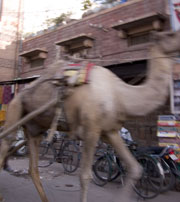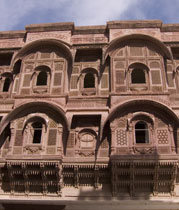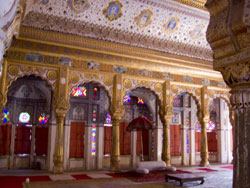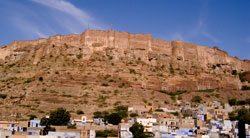The Majestic Fort
I arrived in Jodhpur on the edge of the Great Thar Desert around midday after an uneventful five or six hour bus ride and disembarked into a sea of shouting gesticulating touts intent on making their commissions.
Fortunately I had booked ahead on the condition that the guesthouse send someone to get me so, after dodging the touts as best I could, I found the man I was looking for, hopped on the back of his motorcycle and was whisked out of the chaos into the even greater chaos of sprawling Jodhpur. After putting up my things at the guesthouse and arranging for a ticket on the next sleeper train to Jaisalmer, I went out into the ruckus and commotion of Jodhpur’s clock tower market. The clock tower is the center of the old town in Jodhpur and from the main square countless markets, each street with its own specialty, from vegetables and fruits to jewelry and silverwork as well as everything from sewing machines to internet cafes, take off from the main square. For the first time in India, somewhere between dodging the camels trotting by and saying no to the shopkeepers grabbing my arm, I got lost.
 After snacking on some fresh roasted peanuts and enjoying a pineapple lassi I asked around trying to find my way back to the guesthouse. Indians have a curious way of shaking their heads that seems to move on two axis at once so that you can’t determine anything like yes or no from the gesture. Having observed this movement in context for three weeks now I’ve concluded that sometimes it means yes, sometimes no and most often, I don’t understand what you’re saying but I like to listen to you talk. There is also a feeling here that saying no to anything is rude, so even if someone doesn’t know where something is, they’ll say they do rather than be what they consider rude and say no I can’t help you. I’ve learned the best policy when asking directions is the take a kind of census and go with the majority opinion. Then once you set off it’s best to ask again every now and then and see if the majority opinion still favors your direction. Eventually I made it back to the hotel and everything was fine.
After snacking on some fresh roasted peanuts and enjoying a pineapple lassi I asked around trying to find my way back to the guesthouse. Indians have a curious way of shaking their heads that seems to move on two axis at once so that you can’t determine anything like yes or no from the gesture. Having observed this movement in context for three weeks now I’ve concluded that sometimes it means yes, sometimes no and most often, I don’t understand what you’re saying but I like to listen to you talk. There is also a feeling here that saying no to anything is rude, so even if someone doesn’t know where something is, they’ll say they do rather than be what they consider rude and say no I can’t help you. I’ve learned the best policy when asking directions is the take a kind of census and go with the majority opinion. Then once you set off it’s best to ask again every now and then and see if the majority opinion still favors your direction. Eventually I made it back to the hotel and everything was fine.
The next day I hopped in a rickshaw and headed up to tour Meherangarh, or the Majestic Fort as it’s known in English. As its English name indicates, it is indeed perched majestically atop the only hill around, and seems not so much built on a hill as to have naturally risen out the very rocks that form the mesa on which it rests. The outer wall encloses some of the sturdiest and most impressive ramparts I’ve seen in India or anywhere else and then within that, mainly on the north side, are a series of palaces and courtyards that, when linked together by the various passages, comprise what was once the ruling seat of the Marwar Empire. The current Maharaja does not actually have any more power than a common citizen, but he does have the deed to the fort and, with no revenue source (i.e. taxes go to the federal government of India, not him), he did the smart thing and formed a trust and turned the fort into the Museum. According the audio tour guide, the initial means of raising money for the restoration of the fort came from selling off the fort’s resident bat populations’ guano to the farmers in the surrounding area. At some point wealthy investors begin to pour money into the project, including I noticed the J. Paul Getty Trust, and the Fort is now recognized by UNESCO. It has been beautifully restored and just wandering about its various courtyards and palaces gave the feeling of having stepped back in time a few hundred years.
Each area of the sprawling palace has some fantastical name such as Pearl Palace, Flower Place, or The Courtyard of Treasures which is ringed by arched balconies and hundreds of Jalies (the carved sandstone screens that go over the windows).  Each Jalie is unique in its pattern and the purpose behind them is to provide privacy and yet still let in light, which indeed they do, it is nearly impossible to see in them from the outside and yet on the inside they let through a surprising amount of light which falls in ever-changing geometric patterns that dance across the floor as if forever running away from the sun. The overhanging curved stone eaves of the windows looked like Mongol warrior helmets from a Kurosawa movie, but were actually inspired by the domed huts in the area.
Each Jalie is unique in its pattern and the purpose behind them is to provide privacy and yet still let in light, which indeed they do, it is nearly impossible to see in them from the outside and yet on the inside they let through a surprising amount of light which falls in ever-changing geometric patterns that dance across the floor as if forever running away from the sun. The overhanging curved stone eaves of the windows looked like Mongol warrior helmets from a Kurosawa movie, but were actually inspired by the domed huts in the area.
The roof overhangs with their sweeping oriental curves together with the intricate patterns of the screened windows gives the Courtyard of Treasures a feeling of architectural schizophrenia, embracing the organic and symmetrical and also the asymmetrical and random. This feeling pervades not just this one courtyard, but the whole palace, and yet somehow the way in which the buildings are linked by the walkways between levels forms a bridge between the two styles and holds the design together as a cohesive whole.
 Inside the palace is quite magnificent and contains one room that was the most amazing, lavish room I’ve ever seen anywhere. It was used for poets to recite poetry and musicians and dancers to perform. And to think that most of poets I know have been reduced to reading in the local tavern or some nearly abandoned building on a college campus. I should like to have seen a performance in this room when it was still in use.
Inside the palace is quite magnificent and contains one room that was the most amazing, lavish room I’ve ever seen anywhere. It was used for poets to recite poetry and musicians and dancers to perform. And to think that most of poets I know have been reduced to reading in the local tavern or some nearly abandoned building on a college campus. I should like to have seen a performance in this room when it was still in use.
After finishing up the audio tour I set out to walk the length of the ramparts and ran into a German man who had been on my bus the day before. We smoked a cigarette and strolled along the various stone parapets admiring the myriad of cannons on display, including on extremely beautiful one (if one can say that a object of death and destruction is beautiful), that was apparently captured in China during the boxer rebellion, and took in the sweeping views of the blue city below. Once it was just Brahmins that used the blue on their houses, but these days pretty much everyone does it, the house are painted white and then washed in an indigo dye so that the city, when viewed from on high, looks not unlike a sprawling underwater fantasy world.
The German man, whose name I never did get, was anxious to practice his English so we sat down beside a rather nondescript and long since mute cannon and talked for some time while in the background the sounds of the frenetic clock tower market drifted up the hill with the breeze. He had apparently also been walking around the market yesterday in search of the one street that sells nothing but betel nut in all its various forms. I have seen more than a few betel nut chewers in the last three weeks, it’s a habit that seems on par with the coca leaf chewers in Peru and is apparently just as addictive, except that betel nut juice is bright red and rots the teeth and gums. If you ever come to India and see someone who looks like they got their grill kicked in (as Jimmy would say) the night before, that is your betel nut chewer.
 Later in the evening, after I had returned to the hotel and was waiting for my night train, I sat up at the rooftop restaurant and watched the setting sun turn the distant and very imposing fort ever-brighter shades of red and orange. I tried to imagine the position of an attacking army and what it would require to assault such a fort, which apparently must be more than anyone could ever muster since the fort was never captured. Ten or so India buzzards were circling lazily high of the fort floating on the thermals, some of them able to remain suspended almost perfectly still in the wind, as if they went up there everyday expecting some carnage and feasting they had heard about from their great grandfathers who doubtless could tell tales of carrion banquets after the various attempts to take the fort.
Later in the evening, after I had returned to the hotel and was waiting for my night train, I sat up at the rooftop restaurant and watched the setting sun turn the distant and very imposing fort ever-brighter shades of red and orange. I tried to imagine the position of an attacking army and what it would require to assault such a fort, which apparently must be more than anyone could ever muster since the fort was never captured. Ten or so India buzzards were circling lazily high of the fort floating on the thermals, some of them able to remain suspended almost perfectly still in the wind, as if they went up there everyday expecting some carnage and feasting they had heard about from their great grandfathers who doubtless could tell tales of carrion banquets after the various attempts to take the fort.
Later that night I headed over to the train station and caught a sleeper for Jaisalmer (which I’ve seen spelled that way and also as Jaiselmar—in fact noticing the constant misspellings of English words in India has become a sort of hobby of mine, but this is first time I’ve seen variable spellings on an Indian word). My time in Jodhpur was short, but I wanted to get up into the desert and I still want to see the Taj Mahal so I must keep moving.
Thoughts?
Please leave a reply:
All comments are moderated, so you won’t see it right away. And please remember Kurt Vonnegut's rule: “god damn it, you’ve got to be kind.” You can use Markdown or HTML to format your comments. The allowed tags are
<b>, <i>, <em>, <strong>, <a>. To create a new paragraph hit return twice.